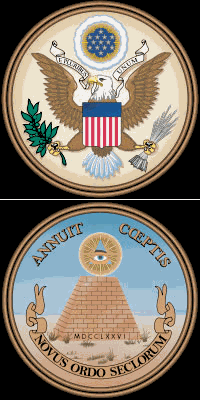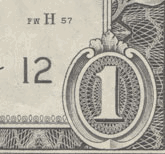Howdy
Folks,
Found
some interesting information on the Internet
you may have missed.
Symbolism and the $1 Bill

Open your wallet, pull out everyone’s
favorite portrait of George Washington, and be prepared to learn about some symbolism that probably seemed perfectly normal in the
18th century. Here are the explanations behind some of the more baffling parts of our nation’s
smallest bills.
What’s that weird pyramid drawing on the
reverse of the bill?
The two circular drawings on the reverse of
the bill are actually parts of the two-sided
Great Seal of the United States.
Although you don’t see the entire seal too often, the notion
of having a great seal is actually as old as
the country itself.
The Continental Congress passed a
resolution on July 4, 1776, to create a
committee to design a great seal for the
fledgling nation, and heavy hitters John
Adams, Benjamin Franklin, and Thomas Jefferson
got the first crack at creating the seal.
|

|
Congress took nearly six years and
several drafts to finally find a
suitable seal. Congress finally approved
of a design on June 20, 1782. |
What’s the story behind the Great Seal of
the United States?
According to the State Department, which
has been the official trustee of the seal
since 1789, both the obverse (front) and
reverse (back) of the seal are rich with
symbolism. The obverse picturing the eagle is
a bit easier to explain. The bird holds 13
arrows to show the nation’s
strength in war, but it also grasps an olive
branch with 13 leaves and 13 olives that
symbolize the importance of peace. (The
recurring number 13, which also appears in the
stripes on the eagle’s shield and the
constellation of stars over its head, is a nod
to the original 13 states.) The shield floats
unsupported over the eagle as a reminder that
Americans should rely on their own virtue and
strength.
The symbolism of the pyramid on the seal’s
reverse is trickier. The pyramid has 13 steps
– the designers apparently never got tired
of the 13 motif – and the Roman numeral for
1776 is emblazoned across the bottom. The
all-seeing Eye of Providence
at the top of the pyramid symbolizes the
divine help the early Americans needed in
establishing the new country. The pyramid
itself symbolizes strength and durability.
The divine overtones don’t stop with the
unblinking eye, though. The Latin motto Annuit
Ceptis appears over the pyramid; it translates
into “He [God] has favored our undertaking.”
The scroll underneath the pyramid reads Novus
Ordo Seclorum, or “A new order of the ages,”
which was meant to signify the dawn of the new
American era.
|

|
How did the seal end up on our dollar
bill?
We can thank former Secretary of
State Cordell Hull’s busy schedule for that one. Secretary of Agriculture
Henry A. Wallace had to wait for a
meeting with Hull in 1934 and decided to
kill time by thumbing through a State
Department pamphlet on the Great Seal.
The pamphlet contained an illustration
of the reverse side of the seal with the
pyramid, and Wallace was quite taken
with the drawing. He took the seal to
President Franklin Roosevelt and
suggested the country mint a coin using
the two sides of the seal.
FDR liked the seal, too. (Roosevelt
and Wallace were both Masons and loved
the all-seeing eye part of the reverse
design, which echoed the concept of the
Great Architect of the Universe.) He
thought the seal should be on the
reverse of the dollar bill rather than a
coin, but he was worried the mystical
imagery would offend Catholics. After
Postmaster General James Farley assured
FDR he didn’t think his fellow
Catholics would have any problem with
the design, Roosevelt approved a new
dollar bill design that first appeared
in 1935. |
The Founding Fathers
may have taken ideas
from a magazine?
Possibly. The familiar E Pluribus Unum
motto that the eagle holds in its beak
underscores the union and togetherness of the
13 colonies. It might also underscore early
Americans’ love of periodicals.
According to the State Department, recent
historical research has indicated that this
Latin motto may have been borrowed from
Gentlemen’s Magazine, a London publication
that ran from 1732 to 1922. The magazine was
popular in the colonies, and its title page
always carried the E Pluribus Unum motto.
Dates on the front of the
bills don't change that often?
At the lower right of the portrait on the
bill’s obverse you’ll see the word “Series”
and a year. You might notice that these don’t
change each year the way the numbers on minted
coins do. Why not?
According to the Treasury, the series date
only changes when there’s a new design for a
bill, a new Treasurer of the United States, or
a new Secretary of the Treasury. (These are
the two officials whose signatures appear on
either side of the portrait.) The series year
itself changes when the Secretary of the
Treasury changes, while a change in the
Treasurer of the United States means that the
series year remains the same, but a suffix
letter gets tacked onto the end of the year.
Various other numbers on the
obverse of the bill?
The bill’s serial number is the most
prominently displayed set of digits on the
dollar, but they’re not alone. If you take
out a dollar, you’ll notice there are four
large numbers in the corners of the bill’s
open space. Like the encircled letter to the
left of Washington’s portrait, these numbers
tell which Federal Reserve Bank issued the
note. (Each Fed’s number corresponds the
letter of the alphabet assigned to the bank,
with A=1, B=2, and so on.)
|

|
The tiny letters and numbers that
appear on the top left and bottom right
of the bill’s obverse indicate the
position of the note on the Treasury’s
printing plates. If your dollar bill has
a tiny “FW” before this code, those
letters indicate that it was printed at
the Treasury’s facility in Fort Worth,
Texas, rather than in Washington, D.C. |
And you thought you knew everything.
HOWDY